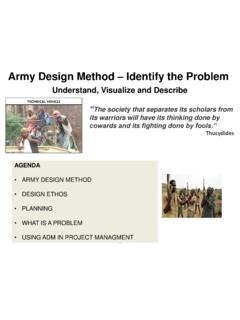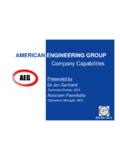Transcription of The Ductile to Brittle Transition - K Street Studio - …
1 THE Ductile TO Brittle Transition . Introduction Body centered cubic metals lose most of the fracture resistance and ductility when temperature is lowered to below the Ductile to Brittle Transition temperature. This temperature is often the lowest temperature at which a structural engineering material can be considered useful. The Transition temperature is also very sensitive to alloy composition and processing. This makes it a useful criteria for quality control. The purpose of this experiment is to measure the Ductile to Brittle Transition temperatures of several plain carbon steels. An aluminum alloy is also tested and compared to the behavior of the steels. The energy of fracture is measured using the Charpy V- notch impact test and the percent Ductile / Brittle fracture are used to determine the Ductile to Brittle Transition temperature. Background History: Why would a steel that is normally capable of sustaining great loads and capable of ductilities greater than 20 percent suddenly, when cold, become Figure 1 A typical Charpy sample, this one showing a so Brittle that it could be shattered by a minor blow mixture of Ductile (dull, gray) and Brittle (shiny, salt or similar impact?)
2 This was the question asked over and pepper) fracture modes. a hundred years ago when fractures occurred in steel structures in severe weather. Since then many similar failures have been documented. There a number of possible reasons for such failures: fatigue, corrosion, fabrication and design errors, poor quality steel, etc. The most dramatic and unexpected cause of Brittle failure in ferrous alloys is their tendency to loose almost all of their toughness when the temperature drops below their Ductile to Brittle Transition temperature. This has been the cause for numerous dramatic and catastrophic failures, the rupture of a million gallon molasses storage tank in the winter of 1911, bridge failures, liberty ships breaking in half in the harbor and at sea during World War II and other disasters (see ASTM STP 158, and the figures and text following the references).
3 The earliest record of such failures dates back to 1879. This was when good, cheap Bessemer and open hearth steels had just begun to become widely used. (The Bessemer process was introduced in 1860. Prior to that, steel had been made by an expensive process of carburizing wrought iron. The expense limited the uses of steel to special applications.) The problem of Brittle failure of steel structures was severe during and just after World War II. Between 1942 and 1952 around 250 large welded steel ships were lost due to catastrophic Brittle failure. Another 1200 welded ships suffered relatively minor damage (cracks less than 10 feet long) while over 1900 riveted ship have broken in two or lost at sea. Over 58 cases of non-ship failures had been reported. Many of these may have failed by non- Brittle processes while many failures probably have gone unreported due to adverse publicity it would generate [3].
4 Department of Chemical Engineering and Materials Science Mike Meier University of California, Davis September 13, 2004. The problem of Brittle failure has not gone away. It is still encountered occasionally. However, we are now more aware the metallurgical factors that influence the Ductile to Brittle Transition temperature and the design practices and fabrication techniques that could lead to Brittle failure. Ductile to Brittle Transition : The Ductile to Brittle Transition is characterized by a sudden and dramatic drop in the energy absorbed by a metal subjected to impact loading. This Transition is practically unknown in fcc metals but is well known in bcc metals. As temperature decreases, a metal's ability to absorb energy of impact decreases. Thus its ductility decreases. At some temperature the ductility may suddenly decrease to almost zero.
5 This Transition is often more abrupt than the Transition determined by the energy absorbed. This temperature is called the nil-ductility Transition temperature (NDTT). The NDTT is lower than the fracture energy Transition temperature and is generally more narrowly defined. The differences between these two Transition temperatures is related to the high rate of loading during impact testing rate sensitive metals. Increased loading rates cause the yield stress to increase while increasing temperature causes ductility to increase. The fracture energy Transition temperature range might not be narrow enough to be able to identify a unique Transition temperature. This is often the case for steels. The width of this range varies for different alloys. Fracture in this range is a mixture of Ductile and Brittle modes of failure. Often criteria other than the energy Transition are used to define the Transition temperature.
6 One method is to specify a fracture energy below which the material is considered to be Brittle . Sometimes the temperature at the halfway point in the Transition is regarded as the Transition temperature. Another method is to define the Ductile to Brittle Transition in terms of a specified amount of Ductile and Brittle fracture. For this method the proportion of Ductile - Brittle fracture is estimated by examining the fracture surface. A 50% Ductile - Brittle fracture surface is the criteria often used to define the Ductile to Brittle Transition temperature. Figure 1 illustrates several methods for measuring the Transition temperature. An examination of a fracture surface will reveal whether fracture occurred by Ductile or Brittle processes. To the unaided eye a Brittle fracture surface has a grainy, salt and pepper appearance. Examination with an SEM clearly reveals the cleavage appearance, river lines and planar microcracks characteristic of Brittle fracture.
7 Brittle fracture can occur intergranularly or transgranularly. Ductile fracture can be recognized by its dull appearance. Ductile fracture is usually transgranular and its fracture surfaces show a significant amount of plastic deformation between roughly spherical microvoids. Charpy V-Notch Impact Testing: The Charpy test is a three point bend impact test. It requires a specimen containing a machined notch in the center of the face facing away from the impacting device and a sturdy machine that can impart a sudden load to the specimen. The Charpy tester consists of a heavy pendulum which is allowed to strike the specimen at the bottom of its arch (maximum kinetic energy, maximum velocity). As the specimen deforms and fractures a portion of the kinetic energy of the pendulum is transferred to the specimen. The specimen is broken and the two pieces of the fractured specimen are knocked clear of the testing machine while the pendulum continues its swing to a somewhat lower position than it was released from.
8 The differences in these heights and the mass of the pendulum determines how much energy was absorbed by the specimen. Most impact testers have a gage that reports this energy so that it doesn't have to be computed. Originally, the Charpy impact test was a crude shop test that was developed to evaluate the effect of notches on fracture behavior. In 1926 ASTM proposed a method for impact testing. In 1933. ASTM standard E-23 was tentatively issued and has subsequently been revised several times. The US Army became involved in 1935. They had discovered that there was an excellent correlation between the ballistic performance of armor and fracture toughness as measured by the Charpy test. However, they found that there was a wide variation in results of impact tests even from qualified laboratories. Upon visiting different installations they found horrible conditions, worn, unsecured and miss-aligned machines, improper centering of the specimen and generally poor procedure.
9 The Army was interested in assuring the accuracy of the results of Charpy tests. They (and others). investigated the effect of variables in testing machines, specimen geometries and test procedures. They also set out to find a method for mass producing specimens that could be used as standards. In 1955 the Army initiated a program of certifying machines on Army contracts. In the early 1960's they began offering the program to the private sector. This program is still offered. For a small charge, the Army will supply standard specimens. After testing them, the specimens could be sent back for further evaluation of the testing machine and, if it passes, the testing machine will be certified. In the first years of the program the rejection rate was 44 percent. A few years later it had dropped to 14 percent. [6] The program is still offered. Standardization of the Charpy test helped the Army argue for increased alloy contents of steels and for more severe quenching practices when producing steel used as armor.
10 It has also resulted in metallurgical innovations that have led to the development of metals with significantly higher impact resistances at similar strengths and hardness. Standardization has also allowed a large data base to be compiled which has enabled correlations to be made with service performance. Current applications of the Charpy impact test include comparisons of heat to heat variations of steel, evaluation of material behavior during either intentional or accidental high rates of loading, evaluation of the effect of irradiation on the embrittlement of steel, evaluation of the effects of microstructure and fabrication on toughness and studies of the fundamental aspects of deformation in bcc materials. Together the tensile test and Charpy impact test form a fairly complete evaluation of the mechanical properties of a material. However, it should be noted that the Charpy test is not a simulation of an alloy in service.










